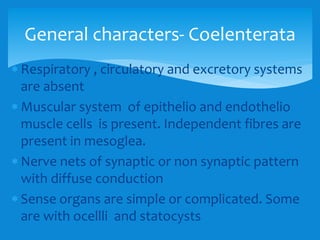Coelenterata general characters & classification
- 1. Coelenterata Bollapalli Ashok Kumar M.Sc.,B.Ed.,M.A(Lit)CSIR-NET,(Ph.D) LECTURER IN ZOOLOGY KRK Govt Degree & PG College ADDANKI-523201 Phone:9652929696,9441635264 Email: ashokkumarzoology@gmail.com
- 2. 9000 living sps and many fossils since Ordovician period Marine , some are fresh watered Proterospongia-link between Protozoa and Coelenterata Ctenoplana- link between Coelenterata and helminthes Cyanea arctica - Big and Long jelly fish-7.5.m radius with 120 yards long tentacles Chirposalmus , Chironex jelly fishes are most poisonous Coelenterates are called stinging animalcules COELENTERATA
- 3. PEYSONNEL (1773) called them as coral insects Linnaeus, Lamark ,Cuvier included these in Radiata Eschscholtz (1829) divided radiata into three groups like Zoophyta, Ecalepha, Echinodermata. He studied Ecalepha and later described Ctenophora and Siphonophora medusae Johnston (1939) separated Hydroidea class Leuckart (1947)formed this phylum including sponges and ctenophora Hatschek (1888) divided it into Spongiaria, Cnidaria , Ctenophora COELENTERATA- Historical Background
- 4. Metazoan multicellular animals Tissue grade of organisation Aquatic animals except Hydra all are marine. Solitary or Colonial, sedentary or free living Radial or bilateral symmetry Two types of individuals- polyp (asexual form) and free swimming medusa (sexual form) General characters- Coelenterata
- 5. Zooids - small animals in a colony . Depending on function, the nature of zooid changes thus shows polymorphism Diploblastic body wall with two cellular layers 1. Outer epidermis 2. Inner gastrodermis 3. Gelatinous mesoglea in between Body layers are with special nematocysts – more in tentacles- many types. Stinging cells useful for killing and protection General characters- Coelenterata
- 6. Acoelomate organisms Digestive system is incomplete anus being absent and mouth for ingestion and egetion. Digestion is intra and extracellular Mouth is with small, thin tentacles which are useful for food capture, ingestion, locomotion and protection Gastro vascular cavity is often branched. It opens outside through mouth General characters- Coelenterata
- 7. Respiratory , circulatory and excretory systems are absent Muscular system of epithelio and endothelio muscle cells is present. Independent fibres are present in mesoglea. Nerve nets of synaptic or non synaptic pattern with diffuse conduction Sense organs are simple or complicated. Some are with ocellli and statocysts General characters- Coelenterata
- 8. Asexual reproduction – budding/binary fission Sexual reproduction by gametes. Sexual forms are monoecious or dioecious Development exhibits planula larva Life cycle is with alternation of generations with polyp generation and medusoid generation General characters- Coelenterata
- 10. Solitary/ colonial, polyp and medusoid forms Radial symmetry Body wall –ectodermis,mesoglea and gastrodermis Gastrocoel is spacious Cnidoblasts are absent Body has thick perisarc.in some animals this is very solid and called coral Polymorphism is seen Alternation of generation Sex cells are formed from ectoderm Fertilization is external Holoblastic cleavage Planula larva 2700 genera included Five orders Ex: Hydra,Bougainvillea,Millipora,Physalia,Velella,Porpita,Helistemma HYDROZOA
- 12. Solitary, medusoid Medusa umbrella or bell shaped with/without stalk Gastrocoel has gastro fibres, Gonads and bifurcated into four radial septa. With tetra radial symmetry umbrella structure is with more mesoglea True velum is wanting. Animal end is with lappets Exumbrellar surface has median manubrium Sex cells derive from gastro dermis and release gametes into gastrocoel Monoecious 200 genera included Five orders included Rhizostoma, Aurelia, Periphylla, Cassiopea, Lucernaria, Charybdea, Pericolpa, Tomoya SCHYPHOZOA
- 14. Solitary/colonial, polypoid marine forms Hexamerous , octamerous ,polymerous, biradial or radio-bilateral symmetric animals Anterior region becomes wide to form oral disc to accommodate tentacles Mesoglea with tissue Gastrocoel has septa formed by mesenteries Epidermis secretes test of CaCo3 or horny material Inner side of mesentery has cnidoblasts Gonads derive from gastrodermis and developed from mesentery. Gametes are released into gastrocoel Fertilisation is external. Life cycle includes planula It inncludes 6100 genera 2 sub classes and eleven orders Pennatula, Metridium, Fungia ,Adamsia, Madripora, Meandrina, Gorgonia, Alcyonium, Tubipora, Heliopora ANTHOZOA















